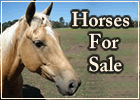

"Should I take my dressage horse out on trail rides?"
PART 1
I think trail and classical riding blend very well together. The horse was definitely used for transportation across the countryside during the classical period of the 17th and 18th centuries so, it is historically correct to use the same horse in the arena that is used in the field. Besides that, riding trails is mentally, emotionally and physically beneficial for show or arena horses to keep them from souring on a steady diet of arena work, to build their courage and dependability in order for them to become a more trustworthy horse and to condition their muscles by negotiating varied terrain.
Another great benefit of trail riding is that very effective dressage training can take place on the trail. When out in the open the horse is more motivated to move out well. The rider can use this natural forward impulsion to improve movements which require more energy from the horse such as shoulder in, haunches in, half pass, leg yield and extending stride. These movements can be accomplished at all gaits as you proceed down the trail. A multitude of gait transitions, lead changes and lateral and vertical flexions may also be precisely practiced on a trail ride without depleting the good swing and forward impulsion of the horse.
When practicing all these movements in the arena the horse, so often, looses energy and mentally disengages, however, when the rider practices these maneuvers while traveling cross country or along wooded trails the horse is more engaged. He does not see the performance of these movements as arduous training on schooling figures but rather considers them as interesting ways to see new country.
I recently rode a client’s dressage horse on a two day trail ride in the Tennessee mountains. The horse had a high amount of energy so, for six hours a day for two days we practiced lots of lateral dressage movements and gait transitions. At the end of the two days a good deal of training was accomplished which I would never have been able to accomplish in an arena setting. You can imagine how little energy you would have in most horses if you tried to train for six hours straight in an arena but on the trail it’s a different story, the horse offers the energy then you just direct it into the specific movements.
If you are riding a horse that has more forward energy than you want, you may attempt to control the energy by fighting with the horse to try to hold him back but this accomplishes nothing more than making you frustrated and making the horse angry. Instead of fighting with the energy, direct it into something constructive by positioning the horse into a dressage movement like shoulder-in for example. In essence you’ll be telling your horse, “Thank you for all that extra energy, now use it to do a nice shoulder-in going down the trail.” Or “If you want to catch up with those horses in front of you so badly, you’ll have to catch up while doing half-pass!”
I was once riding a clients very prancy, jiggy horse on a trail ride and rather than trying to fight against this undesirable movement I just used the horse’s natural pranciness to develop a fairly decent piaffe and passage on the trail.
When working with a high energy horse on the trail I use dressage movements to control speed but frequently offering the horse the opportunity to simply walk along calmly. If the horse takes my offer and decides to walk nicely then we do, but if he speeds up again we go right back to practicing our dressage. This way we never have to fight, I just direct the energy into the feet through the positioning of the horse’s body.
The dressage rider develops a much better independent and balanced seat by riding up and down hills. The horse learns to trust its human leader, the relational bond is strengthened and closer communication between horse and rider is greatly enhanced by taking your horse out on "adventures" in the real world.
Contine to part 2 of horse dressage.

Ed Dabney is an internationally acclaimed clinician, presenting horsemanship and riding clinics all over the US and in Europe. In 2007, Ed was named Champion of the East Coast Trainer Challenge Series by Equine Extravaganza. Ed was honored to have been selected by the University of Georgia to teach their senior level Young Horse Training course.
His training articles have appeared in many major national magazines. Ed produces instructional videos and the “Gentle Horsemanship” TV program which has been seen on RFD-TV.
Ed's blending of natural horsemanship and classical equitation has made an indelible mark with students all across the United States and now also in Europe, drawing the attention of serious riders searching for the lightest touch and the deepest connection with their horses irrespective of breed or discipline.


